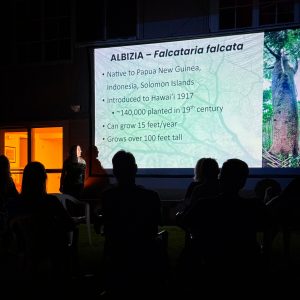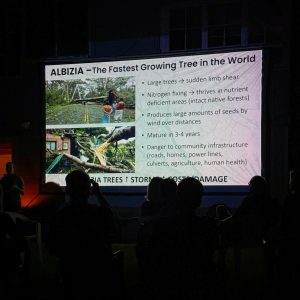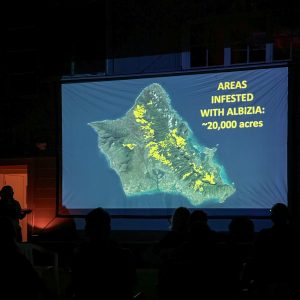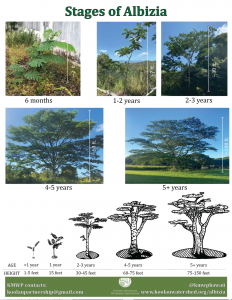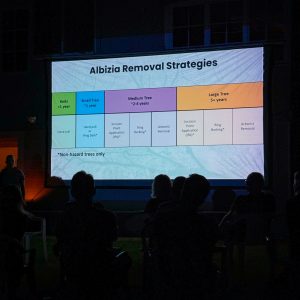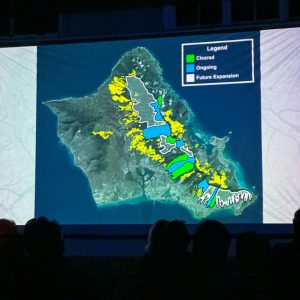Why Remove Albizia: KMWP Presentation

Mahalo to HTMC member John Miller for coordinating the Ko’olau Mountain Watershed Partnership (KMWP) presentation “More About Albizia” on Saturday January 20th at the clubhouse. KMWP’s Community Outreach Specialist Melani Spielman’s presentation was eye opening. Mahalo Melani!
We learned many things about Albizia; from its origin (native to Paupa New Guinea, Indonesia and Solomon Islands), that Albizia is the fastest growing tree in the world, and that Samoa has successfully eradicated Albizia from its islands. Albizia’s seed was spread in Hawai’i in 1917 in an effort to reforest the land. However, as an invasive plant it contributes to our issues of run-off, introduces nitrates to our soil that makes it difficult for native plants to grow which reduces the amount of water that seeps into our aquifer. Albizia has also become known as dangerous because of its shallow root system that allows it to fall over in strong winds along with its process of dropping branches, which can be very large.
It is important to know how to identify Albizia so that when we are trail clearing and/or hiking we can identify and hand pull its keiki in their first year of grown before they become an even bigger problem. Albizia matures in 3-4 years growing 60-75 feet, which also means they can also start spreading their seed. Before trying to remove large Albizia trees, they need to be accessed to find out if they are “hazard” trees (if they grow near power lines, roads, structures, or trails). This process depends on their height which will determine how far they and/or their branches will fall.
Before attempting to remove Albizia trees it is important to understand if they are a “hazard” tree. Small Albizia can be hand-pulled by pulling them out of the soil and making sure their root has been removed. Ring-Barking is a process to remove the bark from 2-3 feet high around the entire tree all the way to the soil level. Using Milestone herbicide is another method that takes an expert trained in the use and application of the herbicide. Do not ring bark or herbicide any hazard trees. Hazard trees should only be removed by an arborist that specializes in Albizia tree removal.
Learn more about how to get involved in this effort to remove Albizia from Oahu at future KMWP Albizia Events at locations all over Oahu. KMWP does other work to help protect the Ko’olau Mountain watershed areas.
Upcoming KWMP Events:
The next KMWP workday is on Saturday February 17th from 9-12pm to help with forest restoration. To get more info, register and/or RSVP CLICK HERE the deadline to sign up is January 27th.
The Patagonia story time event is on Saturday, February 3rd. This is an event for the keiki where they will read a story to the kids, followed by a short presentation and talk about forests, watersheds, conservation, native species, etc., and then they will have open craft time. RSVP LINK.
To sign up for the KMWP monthly newsletter for upcoming events and opportunities every month CLICK HERE.
For more information about Albizia visit the KMWP:
Website: https://koolauwatershed.org/albizia/
Facebook: https://www.facebook.com/kmwphawaii/
Instagram: https://www.instagram.com/kmwphawaii/
Twitter/X: http://twitter.com/kmwphawaii
Or reach out to Alana Miyashiro at KMWP via email: kmwpcommunity@gmail.com




